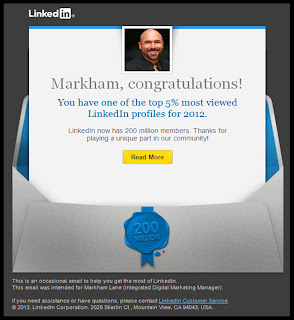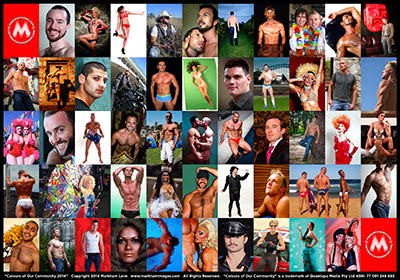We've heard it all too often, CEO's are frustrated that social media doesn't have a sustainable business model and they're struggling to find the Return on Investment (ROI) for developing platforms. But perhaps the perspective of social media as a platform needs to change?
|
markhamimages.com helping you find the ROI within social media networks.
|
For years, I've been focussed on building digital channels and creating marketing strategies that drive traffic into those channels. The secret to success from a Search Engine Optimisation (SEO) perspective has always rested in the creation of original content that satisfies the needs of the target market.
Content marketing requires a distribution network to advertise the release of that new content and this can be achieved via email to subscribers, partners and affiliates, through site optimisation, blogging and also through social media networks. That's right, social media is a distribution network for your original content. It's not a channel that sits in isolation to your other digital assets, it drives traffic to those assets.
So how do we find the ROI from social media?
1. Define the Key Performance Indicators (KPIs) and Measure Them
In order to hold any marketing channel accountable, there must be a framework of metrics that can be tracked, compared to, benchmarked and analyzed over time. Websites and mobile sites are no different.
Of course, every business is unique and the way each business markets themselves is going to have a different set of parameters for defining success but the tried and tested benchmarks for site performance is based on traffic - where it came from, what they were interested in, how long they stayed for and whether that traffic managed to convert on the page goal and monetise.
Google Analytics goes a long way to provide reporting on these numbers but some companies go further in exporting these statistics into software that amalgamates site traffic with customer, prospect and (social media) audience relationship. This approach helps businesses determine necessary adjustments to their overall business model to improve upon channel marketing goals, as the empirical data provides insights in a complete loop of customer lifecycle management.
2. Define the Social Media Indicators and Improve Upon Them
Like print advertising, radio or TV, social media is just another platform to communicate your brand message. The only difference being that the audience is in control of what information is consumed and they directly influence their immediate network with what they think about it.
It’s this factor alone that makes the argument that every digital business must produce compelling, engaging and entertaining original content to satisfy the needs of their target market. That’s the only way to get your audience to become the distribution network of your brand messages.
When looking to assign accountability to social campaigns, the first step is to define KPIs and measure against them. I call them them the EPI’s. They are:
E. Engagement vs Reach
Engagement refers to the number of people who actually interacted with your post and this figure is the benchmark to how successful your post was. Time of your post, the content it contained and how relevant it was in the minds of your audience all play a factor here.
Reach refers to the impressions that social channels provide to a campaign, addressing the greatest value of social media marketing: tapping into the power of the network to market to previously unreachable prospects. In addition, the Reach through social channels increases a brand’s credibility, as new consumers are touched by social campaigns, so too their friends or other connections on the social platform see those connections. For example, a consumer seeing a friend recommend a brand as a result of a social campaign has a much greater impact than seeing a static ad from the brand on the social page.
P. Performance - Monetization or Conversion
Performance of your social program must contain a subset of outcomes that are predefined, in order to convert traffic or monetize from it, using a subtle call to action approach at the conclusion of the content you’re seeding. Subscriptions to email lists, product purchases, signing up as a Facebook fan or downloading a free trial are all examples of calls to action.
In order to measure monetary contributions to business goals, a value must be assigned to the call to action for the social campaign, with conversions being tracked. A valuable call to action is sometimes not a sale. In fact, it could be motivating users to generate content to be added to the next social campaign.
I. Sharing Behavior of Influencers
Influencers (a.k.a. advocates for your brand) are essential to maximizing the viral impact of your social media campaign. In order to leverage them properly, you need to determine the level of engagement between an influencer and the members within their social graph.
Yet, not all influencers are created equal. Some are brilliant at sharing a message but don't engage with their peers. Others don't generate much buzz but their peers take their advice. Understanding who your influencers are within your audience and customer base is critical to optimizing program performance. There are a number of Influence Marketing tools that help to define, rank and engage with your influencers, such as
Kred and
Klout.
The combination of these three EPI’s (Engagement, Performance and Influence) provides clear program success criteria and can be weighted based on a program’s objectives. In the case of an awareness campaign, a marketer may place more weight on reach and sharing activity. In the case of a direct response program, the opposite weighting could be applied.
3. Creating Predictable Results
When searching for potential Influencers to share a brand message in your social media campaign, the number of friends a person has on Facebook or the number of followers they have on Twitter is important, but it’s not the most important factor. The real key to producing a predictable campaign is accurate targeting.
The most successful campaign targeting begins within a CRM database, where deep insights into your customers are available. Accountable marketing campaigns need to be predictable, and predictability can only be driven in social media once you have identified your most engaged customers and who among those are willing to advocate on your behalf.
4. Providing Incentives to Foster Viral Activity
You may have read my previous blog post on
how to create a viral social media campaign. Viral activity from a set of Influencers needs to be encouraged in-order to create predictable results. Equally important, is the need to influence social participation within the campaign. Incentivized sharing provides this level of predictability as well as an opportunity to throttle activity.
The key message here is about rewarding customers for their behavior. Airlines, hotels, financial institutions and even coffee shops consistently reward customers for their loyalty. The same principle can be applied in your social media campaign, with bi-directional incentives built into the program. Reward the influencer for inviting friends to participate in a social campaign and then reward the influencer’s friends for acting on the viral invitation.
In other words, both the brand advocate and the advocate’s friend are treated like VIP’s.
Programs that include bi-directional incentives perform better than those that rely solely on altruistic motivation for sharing activity. Being transparent about the incentivized offers, the integrity of the channel is maintained while staying in control of performance measurement EPI's like engagement, reach, performance and influence.
Social media as a distribution network for your original content leads to more traffic to your digital platform. Should your business need review of your digital marketing strategies, author
+Markham Lane can be contacted on
+61-414-446-660 to provide these services. See the website www.markhamimages.com for more information.







































